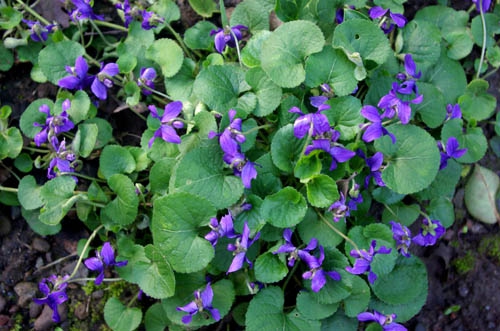The wild violet is a weed that primarily is perennial; cool, seasoned and had broad leaves. It prospers in moist, shady areas and blooms early in spring, earlier than most other plants. The height that the wild violets often reaches is between 2 to 12 inches. They have a fibrous root system that is dense. Their leaves are heart shaped with scalloped edges. Due to the constant hybridization of weeds, leaf shapes may vary.

Wild Violet Weed Growth Basics
The wild violet weed is indigenous to North America. According to the USDA, it grows in hardiness zones 3 through 9.
Sun and light. Wild violets prefer partial sun. They do not require a lot of sun like mot weeds and grown in spaces that have shade and are a bit damp.
Soil. The soil they prefer is moist. They will not grow good enough in dry soil that is well-drained. These conditions will lead to optimum growth of this weed if required for landscaping.
Varieties. But it is worth noting that there are a variety of wild violets. Those who have tried to remove them will know first-hand how tricky they can be. Even in less than optimum conditions or conditions of drought these weeds can survive better than the grass on your lawn. Wildflowers are much better at survival than other plants and the wild violet weeds are no different.
How to Get Rid of Wild Violet Weed
Some people commonly spray roundup, which is glyphosate on them. This assumes that the weeds are sufficiently separated from other plants and that you are not an organic gardener.
If you cannot solve the weed problem by the method of glyphosate then another way is to dig them up. A spade or digging fork can be used to dig out these weeds. The soil should be loosened by digging from a foot away. In lawns where excessive digging isn’t possible, try to use a sharp knife to dig them out. But it is crucial to understand that digging them up is not always the best option. Even if the tiniest bit of root is left behind a new plant will shoot up. This will end up creating a lot of holes in your garden and you will have to keep repeating the eradication procedures.
Hand pulling is a laborious option but it can often be the best way to control wild violet weeds for organic growers. The key to hand weeding is persistence. Multiple pulling sessions from spring through the summer are required. The trick is to get the entire weed else they can grow back easily. Before trying any hand weeding, make sure the soil is moist or soft else there is no use.
Trying to kill the weeds as they are growing in the lawn is even worse. The holes will destroy your lawn. Lawn weeds cannot be controlled by Mulch. Hence we have to recommend herbicide (weedkillers) as an ultimate solution to get rid of your lawn weed. You will have to follow up with repeat spraying to ensure complete eradication.
The most effective spraying time is during the autumn months. This is usually the period when plant food is travelling to the roots in preparation for the winter months. When herbicide goes along with that food, it can cause serious damage to the roots of these wild flowers. You will have to follow up this application again in the coming months to ensure lasting and complete results.
Surfactants are recommended to be used along with the spray so that the surface tension of the waxy leaves can be reduced. Commercial surfactants are readily available in markets, but if you want to save money you could use dish soap instead with a dosage of a tablespoon per gallon of spray.
Apart from the use of herbicide other ways in which wild violets can be removed at different stages are:
Young weeds can be pulled from the soil if detected early on. In wet soil they can be easily pulled out. If you plan to use them as compost, fry them out for a day or two to ensure no further weeding from them.
Mulching the area you weed is a good option. Apply mulch over the areas from where you have pulled out weeds. This will make the regrowth of the plant extremely difficult.
Notes: Uses of Wild Violets
Wild violets are left alone by many people because of their beauty and due to the fact that some people want to avoid herbicide use. The effort that one puts in weed control often isn’t worth removing these wildflowers as in the end most homeowners seem to love these.
An important use of these weeds is that they are edible. They have a taste similar to nuts. Both their flowers and leaves are edible. The young leaves are preferred.
These wild flowers also have herbal medicinal qualities. They contain salicylic acid. This is beneficial for skin softening, removal of corns and warts and it is also fungicidal.
In the end it depends on whether you find these weeds aesthetically pleasing or not. They have their merits and they have their fan following but for some people they will always remain weeds and they would much rather have them removed. Other however, embrace their uses and their beauty and willingly make them a fixture of their gardens and laws.

View All Comments /Add Comment